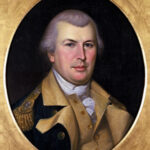The story, “The Legend of Sleepy Hollow”, written in 1819 by Washington Irving, has been depicted as a horror story for over a hundred years, and at first glance this characterization seems well deserved; as it has all the makings of a horror story. In the story there is a projection of good vs. evil, in which the figure projected as evil wins. In the competition for a young woman’s, Katrina Van Tassel’s, heart. In the story Ichabod Crane, the protagonist, tries to woo Katrina by showing off his best qualities, while Brom Van Brunt, the antagonist, tries evil tactics of trying to embarrass Ichabod any chance he can.
Ichabod is a gentleman and traveling school teacher who settles in a place called Tarry Town, and he stays in the homes of the students he teaches. At the same time, Brom is simply known for being an arrogant brute around town. At the end of the story, however, Brom ends up with Katrina’s heart. Then at night and Ichabod suddenly vanishes. There were two possibilities for this. One, either a headless horsemen who has been a mythical figure in the small town came by and carried him away, or two, Brom dressed up as the headless horsemen and scared Ichabod out of the town.
It has all the makings for a good horror story. If you take a closer look at Irving Washington and the time period he wrote this story, there appears to be an alternate meaning. “The Legend of Sleepy Hollow” symbolizes Irving Washington and other men’s short comings during the shift in the American market from paper, gold, and silver to credit.
After the War of 1812 the United States economy started to shift from the old gold and silver standard to depending heavily on credit (Blackson). Credit was becoming more popular and was more convenient for people to do rather than carrying around coins and paper. According to Robert Blackson a member of the Society for Historians of the Early American Republic, more people were using loans to buy things, and in some cases, buying all things. The problem was that the banks were giving out loans too often and to people who didn’t qualify (Blackson). This is sort of the problem our economy is facing today that has plummeted it to one of its worst periods ever.
Washington Irving, according to David Anthony a writer for Early American Literature, was one of many men that got caught up in the shift to credit. Irving was humiliated and nervous during this crisis (Anthony). “The Legend of Sleepy Hollow” symbolizes the significant impact that this era had on Irving and his writing. There are many situations in the text that supports this idea.
The first point of evidence is the character of Ichabod Crane. Ichabod could be said to be portrayed as Washington or any of the other men consumed by the idea of credit. Ichabod is a school teacher who, “lived successively a week at a time, thus going the rounds of the neighborhood.” (Washington) Meaning he doesn’t have anything to his name and he doesn’t have anything really behind him, much like a person who does things on credit. People who buy things on credit don’t have the money behind them to back them up.
Another piece of supporting evidence is the competition between Ichabod Crane and Brom Van Brunt for Katrina Van Tassel’s heart. Katrina was the daughter of a wealthy farm owner, and many men were after her heart. Ichabod noticed her and saw the riches winning her heart would bring him and decided to try and woo her. “Ichabod, therefore, made his advances in a quiet and gently insinuating manner (Washington).” This is an example from the text of how he would try and woo Katrina. He had to use his charm, as he had nothing else to show her. This symbolizes a man buying something on credit, with nothing physically to provide, just the charm and easy thought of credit.
Brom Van Brunt used different tactics to woo Katrina. Brom was the town brute, who had all the muscles and showmanship someone could possess. He symbolizes the idea of hard money by being solid and being able to look at him and see what you’re getting. He used this to his advantage in attempting to woo Katrina by, as the book says, “double the schoolmaster up, and lay him on a shelf of his own schoolhouse (Washington),” meaning he is going to try and embarrass, and make a fool of Ichabod. Much like how money is, he used his physical appearance and known qualities to buy Katrina’s heart.
The competition heated up, and it came down to one night when the Van Tassel’s had a house party and the two competitors were there. Ichabod goes into the evening thinking he has won her over and she is going to pick him. He got his moment with Katrina and was positive he would be picked, but then as the story goes, “Something, however, I fear me, must have gone wrong, for he certainly sallied forth, after no very great interval, with an air quite desolate and chapfallen (Washington).” She had picked Brom.
Throughout the whole story, Washington made Ichabod look like the better choice by making his charm and kindness stand out, trying to symbolize him using his credit to buy her love. At the end of the competition Brom won though. Symbolizing that hard money would beat out credit, and that even though credit has looked appealing and seemed like the better choice, hard money was actually the winner.
After the house party where Ichabod realizes he has lost, the headless horsemen that has been mentioned earlier in the story makes his appearance. The headless horsemen is a ghostly apparition who rides his horse around the town’s graveyard at night talked about throughout the story. Ichabod was riding home from the party when he encountered the headless horsemen. The horsemen came charging from behind and caught up to Ichabod, “Just then he saw the goblin rising in his stirrups, and in the very act of hurling his head at him. He was tumbled headlong into the dust, and Gunpowder, the black steed, and the goblin rider, passed by like a whirlwind (Washington).” The next day Ichabod wasn’t found anywhere, and all but his horse and his hat had vanished.
The headless horsemen symbolizes the fate of the men who use credit too often. When Ichabod was already at a low point and just realized he had lost his prize, the headless horsemen came by and took away any hope he had left. Much how men were figuring out that credit couldn’t buy them everything and wouldn’t always work out; Ichabod was figuring out that his charm couldn’t win him everything. Then much like the headless horsemen, the men’s realization of their financial situation would destroy whatever hope they have left.
“The Legend of Sleepy Hollow” symbolizes Irving Washington and other men’s short comings during the shift in the American market from paper, gold, and silver to credit. There is a lot of evidence within the text and in Irving Washington’s past to support this analysis. Even though “The Legend of Sleepy Hollow” makes for a great horror story, there is a bigger meaning to it, and it summarizes the story of many Americans during a rough economic time.
Work Cited
Anthony, David. ‘Gone distracted’: ‘sleepy hollow,’ gothic masculinity, and the panic of 1819.” Early American Literature 40.1 (Wntr 2005): 111(34). Academic OneFile. Gale. Michigan State University Libraries. 28 Apr. 2009
.
Blackson, Robert M. “Pennsylvania Banks and the Panic of 1819: A Reinterpretation.” Autumn 1989. JStor. Michigan State University Libraries, East Lansing, MI. 28 Apr. 2009 .
Washington, Irving,. Legend of Sleepy Hollow. New York: Atheneum Books for Young Readers, 2007.




